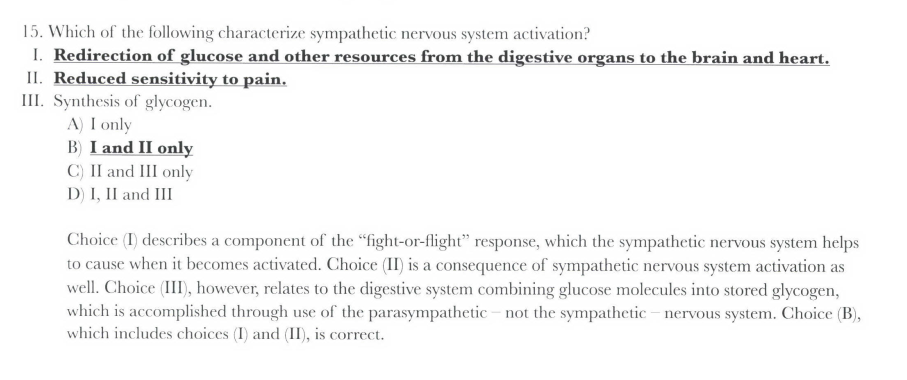So, how true is number 2? I read like 4 papers saying 2 different things.

multiple images upload
@aldol16 @Pono_0001

multiple images upload
@aldol16 @Pono_0001

so, is it something that i should remeber? because it looks a bit risque, it;s one of those things that only true based on the content.From just a gut response based on logic alone, I would say II is most likely true because if you're in a fight-or-flight response mode, you would want to temporarily suppress pain. So say you were trying to run away from a lion in the jungle. You're running through a thicket and your legs are going to get cut up but you don't want to notice that because you don't want to stop to deal with it at that time - and you don't feel the cuts until later. That's why people always say to "let the adrenaline wear off first" after an injury.
Impaired blood flow to the pain region has been observed in persons with both chronic regional and widespread pain during various provocations, e.g., cold water, needle stimulation by acupuncture, and static or dynamic contractions (Acero et al. 1999; Larsson et al. 1999; Sandberg et al. 2005; Elvin et al. 2006; Hallman et al. 2011); for comprehensive reviews on this topic see Passatore and Roatta (2006) and Vierck (2006).
In these pain conditions, it has been argued that enhanced sympathetic activity may contribute to impaired blood flow and nociceptive muscle pain due to an imbalance between vasoconstriction and vasodilatation (Passatore and Roatta 2006). When the oxygen demands are not adequately met, the muscles become ischemic and the local accumulation of metabolites may result in nociceptor activation, which, in turn, can enhance sympathetic outflow (Passatore and Roatta 2006; Vierck 2006). Hence, excessive sympathetic activation may play an important role in generation of muscle pain by mediating the response to various kinds of physical and psychological stressors. Once pain has become chronic, additional effects on ANS regulation can also be expected. First, amplification of afferent nociceptive signals may activate the sympathetic system through somato-sympathetic reflexes (Sato and Schmidt 1973); this occurs at a central level. This activation may result in further intensification of pain due to sensitization occurring at both the peripheral and central levels. Second, chronic pain is a strong psychological stressor that also activates the sympathetic system. As such, it seems possible that chronic pain can be maintained through a self-perpetuating (vicious) cycle.
Empirical support for this model is gained from studies examining widespread pain (fibromyalgia). Bengtsson and Bengtsson (1988) demonstrated that blocking the sympathetic stellate ganglions relieved pain in fibromyalgia patients, and they hypothesized that this was due to improved microcirculation. More recently, it was found, in a randomized controlled trial, that injections of norepinephrine (noradrenalin) evoked pain in fibromyalgia patients (Martinez-Lavin et al. 2002).
An alternative explanation for blunted blood flow response to stress in people with chronic muscle pain, proposed by Maekawa et al. (2002), is ß2-receptor down regulation due to prolonged sympathetic activation. This would also explain a blunted blood flow response to stress, owing to a lack of vasodilatation. Further experimental and clinical studies are needed to elucidate the possible relationships between sympathetic function, impaired blood flow regulation and nociceptive sensitization in pathogenesis of chronic muscle pain
I am afraid that the original question and both supposedly correct answers are all quite misleading.
First of all, as for the possible answers, the original question seems to refer to a fight-or-flight response -as aldol16 suggested- and not just to an activation of the sympathetic nervous system. But even so, both I and II answers are still basically incorrect.
The fight-or-flight response produces an hepatic activation which basically rises glucose circulating (blood) levels. It is only indirectly, as far as digestion is slowed down and as heart rate increases, for example, that a fight-or-flight response will produce a reduction or increase of glucose consumption in different organs... but to call this a "redirection of resources from one organ to another one" is but a simplistic metaphor, and I feel a quite inappropriate one in a neuroscientific context. More so when explicitly referring to a sympathetic activation and not to a fight-or-flight response.
The second answer is even more misleading. While it is true that in a fight-or-flight response there is a reduction of pain sensitivity this is a complex consequence of central inhibition and gating effect mediated -in part- by NE production. But this inhibition of pain sensitivity is not a direct -and nor an indirect- consequence of sympathetic activation but in fact a consequence of the same stimuli that activate a generalized sympathetic response. And so reduced pain sensitivity does not characterize sympathetic activation -although you could say that it happens within a fight-or-flight response.
So, no; I do not think there is anything you should remember in that question-answer example.
As for your later examples on chronic pain, as Pono_001 has suggested, the relation of excessive -chronic- sympathetic activation (and other sympathetic dysfunctions) with pain syndromes is not due to any basic function of the sympathetic nervous system. I guess that basically, what you should remember, is that sympathetic activation does not have a direct effect on pain modulation, even though sympathetic disfunction or the concomitant effects of a generalized sympathetic activation could mediate an increase or decrease in pain sensitivity.
